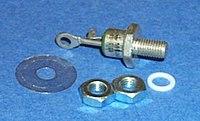
Photo from wikipedia
A LiNbO3-loaded microwave cavity pumped with weakly AM-modulated 30 fs optical pulses was used as a platform to investigate AM-to-PM conversion in the optical rectification process. Theoretical treatment of AM-to-PM… Click to show full abstract
A LiNbO3-loaded microwave cavity pumped with weakly AM-modulated 30 fs optical pulses was used as a platform to investigate AM-to-PM conversion in the optical rectification process. Theoretical treatment of AM-to-PM conversion (i.e., peak-induced electrical phase deviation βi due to optical power modulation with index m) suggests that the dominant mechanism is self-group-velocity modulation due to χ(3) and cascaded χ(2) processes with a value of δ=βi/m=-151 dB, linearly dependent on the optical power at intensities of 6×1010 W/m2 in a 40 mm long LiNbO3 crystal. This is in stark contrast to p-i-n photodiodes which can exhibit an AM-to-PM conversion gain δ>0 dB. In this experiment, we measured values of δ for a resonant optical rectification detector using typical mode-locked Ti:sapphire laser pulses (100 MHz, 30 fs, Pavg≈100 mW) and found an instrumentation-limited lower bound of δ≈-43.5 dB, independent of the optical power.
Journal Title: Optics letters
Year Published: 2017
Link to full text (if available)
Share on Social Media: Sign Up to like & get
recommendations!